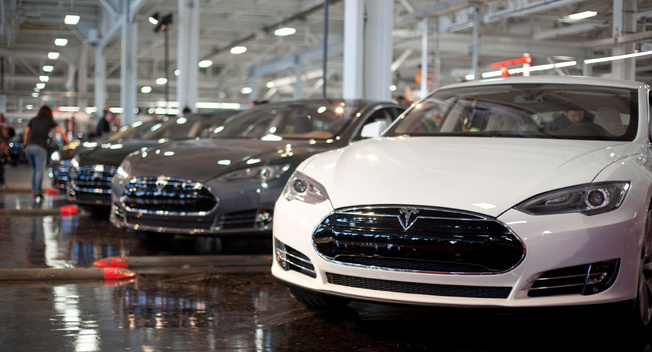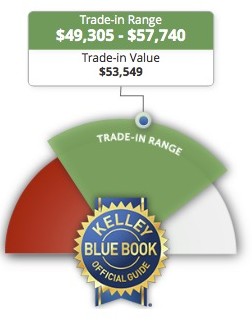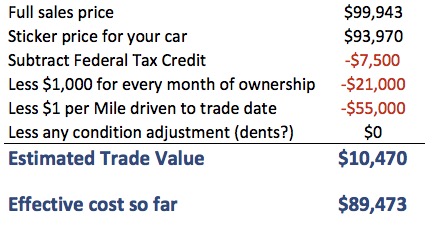Lifestyle
The Cost of Selling Your Tesla and Buying a Newer Model

With Tesla constantly releasing new updates, it’s inevitable that your newly purchased Tesla will one day feel outdated. A prime example would be the flood of RWD Model S’ that hit the second hand market after Tesla announced that it would release the dual motor “D” variant. And now with the Model X available, Model S owners are thinking about trading in their beloved electric sedan for the newest shiny Tesla with falcon wing doors. I would be one that falls into this category. Here’s my analysis on what it would cost to upgrade to a newer Tesla.
A short while ago I configured a Model X and a Model S to specifications that I would buy in present day. This came out to $103,200 and $88,450 respectively after available tax credits. For reference my current Model S cost me $92,443 after tax credits.
Understandably, Tesla does not offer a retrofit for the autopilot hardware though we calculated a hypothetical $67,000 cost to upgrade if it were available. Maybe one day Tesla will offer upgradeable hardware but for now having recurring firmware updates that refreshes functionality on the car isn’t so bad.
Trade Ins
If I were to use Tesla’s math to compute trade in value for my 21 month old Model S with 55,000 miles, it would theoretically have a value somewhere along these lines:
This math is clearly not accurate, and since I was seriously considering the Model X or a newer Model S, I asked Tesla for a true trade in value.
Tesla came back with a trade in value of $49,200. Their resale price as a CPO vehicle would be $55,100:
This is a heck of a lot better than the original formula, but I’ve still used 48% of the original value in less than 2 years. At this trade in value, the effective cost of trading up to new X or S would be $54,000 and $39,250, respectively.
CPO Comparisons
My trade in value made me curious on what other CPOs sold for so I hit up the excellent EV-CPO Consolidator which provides a great deal of information about Tesla CPO cars.
Browsing that site you’ll be hard pressed to find a 2014 Model S with anything close to my mileage. The closest I found was a 2014 Model S in Los Angeles with 48K miles listed for sale at $55,600, just a bit above the quote I got. I don’t know if that car is in as good a shape as mine (I’ve seen some really beat up CPO cars), but the pricing, age and configuration are at least consistent with my quote.
As you’d expect mileage and available features make the most difference in the CPO price. 2014 S85 model CPO prices can range from a low of $55,600 to $79,200 for a low mileage, late 2014 loaded Model S. Within New England the range is only from $56,200 to $67,400.
Kelly Blue Book
 Next stop was Kelly Blue Book. Their trade in value came in between $49,305 and $57,740 with an average of $53,549. My Model S, before taxes, was $93,970. So the trade in price per Kelly Blue Book is 57% of the original price.
Next stop was Kelly Blue Book. Their trade in value came in between $49,305 and $57,740 with an average of $53,549. My Model S, before taxes, was $93,970. So the trade in price per Kelly Blue Book is 57% of the original price.
If you believe the KBB quote, Tesla is on the low end of the trade in values. This seems to be consistent with some posts I’ve seen on TMC and the Tesla forum. If you find your own dealer and trade directly with them you can potentially increase your trade in value by up to $5,000. If you sell privately you may be able to get up to $10,000 more over Tesla’s offer.
Selling privately however can bring its own set of problems, especially in states like Massachusetts where there are strong Lemon Aid Laws that allow individuals to buy a car, drive it for 7 days and then bring it back for a 100% refund if for some reason there’s an issue with state inspection. Selling privately also comes with a huge commitment to arrange for test drives and educate your driver on how to operate an EV. Here in New England EVs aren’t everywhere yet and the Tesla is still a rare car to see.
Competitive Comparisons
To see how other cars “in the same class” compare to the Model S in terms of trade in value, I picked the Porsche Panamera S. E-hybrid to benchmark against. The average trade in value for that car is $53,746 which is very comparable to my Model S. Configuring a Panamera will drive you crazy but it seems that a new one similarly configured would go for $95,270 before taxes. So the trade in price per Kelly Blue Book is 56.4% of the original price, which is about the same as the Model S.
According to EVObsession, the Mercedes S-Class was #1 in the Large Car Luxury Market in 2014, but the Model S blew past that in 2015. I came up with a new price of $91,328 and an average trade in value (same mileage/year as mine) of $57,782 or 63.2% of the original price — the Mercedes seems to retain a bit more value although they’re still in the same range.
Summary
That very first mile you put on your new car has a huge effective cost whether it’s on a Tesla or any other car from a different manufacturer. Trade in values for Model S’ are in line with other cars in its class, although Tesla’s trade in value tends to be on the lower end of the spectrum.
If you’re looking to get top dollar for your used Model S, consider trading it in to a company other than Tesla or selling your Model S privately. Both bring additional levels of hassle but that extra lift can be worth the additional value.
Even if I were to receive $5,000 over Tesla’s trade in value, I’d still be looking at an upgrade cost of over $30,000 to trade up from my Model S (which is less than 2 years old) to a new dual motor Model S with autopilot, upgraded seats, and all of the other improvements and tweaks Tesla made over the last couple years. Is it worth it?
If the gap was closer perhaps the decision would be a lot easier, but in this range for me, and with the recent news that Tesla will be adding more autopilot hardware in the future, I think keeping my Model S and enjoying it is the right way to go.
Besides, with more Model Xs hitting the streets every day, the all wheel drive “D” Model S will inevitably start appearing as CPO inventory. This will open up a whole new world of options. Wait and see is probably still the best choice for those looking to trade up from an earlier Model S.

Lifestyle
Tesla Model S Plaid battles China’s 1500 hp monster Nurburgring monster, with surprising results
There is just something about Tesla’s tuning and refinement that makes raw specs seem not as game-changing.

The Tesla Model S Plaid has been around for some time. Today, it is no longer the world’s quickest four-door electric sedan, nor is it the most powerful. As per a recent video from motoring YouTube channel Carwow, however, it seems like the Model S Plaid is still more than a match for some of its newer and more powerful rivals.
The monster from China
The Xiaomi SU7 Ultra is nothing short of a monster. Just like the Model S Plaid, it features three motors. It also has 1,548 hp and 1,770 Nm of torque. It’s All Wheel Drive and weighs a hefty 2,360 kg. The vehicle, which costs just about the equivalent of £55,000, has been recorded setting an insane 7:04.957 at the Nurburgring, surpassing the previous record held by the Porsche Taycan Turbo GT.
For all intents and purposes, the Model S Plaid looked outgunned in Carwow’s test. The Model S Plaid is no slouch with its three motors that produce 1,020 hp and 1,420 Nm of torque. It’s also a bit lighter at 2,190 kg despite its larger size. However, as the Carwow host pointed out, the Model S Plaid holds a 7:25.231 record in the Nurburgring. Compared to the Xiaomi SU7 Ultra’s record, the Model S Plaid’s lap time is notably slower.
Real-world tests
As could be seen in Carwow’s drag races, however, Tesla’s tech wizardry with the Model S Plaid is still hard to beat. The two vehicles competed in nine races, and the older Model S Plaid actually beat its newer, more powerful counterpart from China several times. At one point in the race, the Xiaomi SU7 Ultra hit its power limit due to its battery’s temperature, but the Model S Plaid was still going strong.
The Model S Plaid was first teased five years ago, in September 2020 during Tesla’s Battery Day. Since then, cars like the Lucid Air Sapphire and the Xiaomi SU7 Ultra have been released, surpassing its specs. But just like the Model Y ended up being the better all-rounder compared to the BYD Sealion 7 and the MG IM6, there is just something about Tesla’s tuning and refinement that makes raw specs seem not as game-changing.
Check out Carwow’s Model S Plaid vs Xiaomi SU7 drag race video below.
Lifestyle
500-mile test proves why Tesla Model Y still humiliates rivals in Europe
On paper, the BYD Sealion 7 and MG IM6 promised standout capabilities against the Model Y.

BYD is seeing a lot of momentum in Europe, so much so that mainstream media has taken every opportunity to argue that the Chinese automaker has beaten Tesla in the region. But while BYD sales this year in Europe are rising and Tesla’s registrations remain challenged, the raw capabilities of vehicles like the Model Y are difficult to deny.
This was highlighted in a 500-mile challenge by What Car? magazine, which showed that the new Tesla Model Y is more efficient, cheaper to run, and more reliable than rivals like the BYD Sealion 7, and even the nearly 400 KW-charging MG IM6.
Range and charging promises
On paper, the BYD Sealion 7 and MG IM6 promised standout capabilities against the Model Y. The Sealion 7 had more estimated range and the IM6 promised significantly faster charging. When faced with real-world conditions, however, it was still the Model Y that proved superior.
During the 500-mile test, the BYD nearly failed to reach a charging stop, arriving with less range than its display projected, as noted in a CarUp report. MG fared better, but its charging speeds never reached its promised nearly-400 kW charging speed. Tesla’s Model Y, by comparison, managed energy calculations precisely and arrived at each stop without issue.
Tesla leads in areas that matter
Charging times from 25% to 80% showed that the MG was the fastest at 17 minutes, while Tesla and BYD were close at 28 and 29 minutes, respectively. Overall efficiency and cost told a different story, however. The Model Y consumed 19.4 kWh per 100 km, compared to 22.2 for MG and 23.9 for BYD. Over the full trip, Tesla’s charging costs totaled just £82 thanks to its supercharger network, far below BYD’s £130 and MG’s £119.
What Car? Magazine’s testers concluded that despite BYD’s rapid sales growth and the MG IM6’s seriously impressive charging speeds, Tesla remains the more compelling real-world choice. The Model Y just offers stability, efficiency, and a proven charging infrastructure through its Supercharging network. And as per the magazine’s hosts, the Model Y is even the cheapest car to own among the three that were tested.
Watch What Car? Magazine’s 500-mile test in the video below.
Lifestyle
Tesla Cybertruck slapped with world’s least intimidating ticket, and it’s pure cringe
One cannot help but cringe and feel second-hand embarrassment at the idea of a person just driving around with a stack of these babies.

A Cybertruck parked at Stanford Shopping Center in California was recently hit with what might be the most try-hard piece of paper ever slipped under a wiper blade: a “fake citation” accusing the driver of supporting a “fascist car.”
The note, shared on X by Tesla staff program manager Ryan Torres, quickly made the rounds on X, where it quickly gained attention as an example of how not to protest.
The world’s least intimidating ticket
According to the citation, the supposed “violation” was “driving a fascist car.” The remedial action? Take the bus, call an Uber, or ride a bike. The note also dubbed Elon Musk a “chainsaw-wielding Nazi billionaire.” Now, protests against Tesla and Elon Musk have become commonplace this year, but one cannot help but cringe and feel second-hand embarrassment at the idea of a person just driving around with a stack of fake anti-Tesla/Musk citations.
Torres pointed out the irony himself in his post on X. Tesla currently employs over 140,000 Americans, and SpaceX has put the U.S. firmly back at the top of space technology. As Torres put it, maybe the person behind the world’s least intimidating ticket should “read a book on innovation before vandalizing” other people’s property.
Peak performative clownery
Not to mention that the fake ticket’s logic collapses under its own weight. EVs like the Cybertruck are literally designed to reduce emissions, not “destroy the economy.” If anything, Tesla has bolstered the United States’ economy by fueling jobs in engineering, manufacturing, and clean energy. It’s not the first time a Tesla has been the target of vandalism or politically charged notes, but this one stands out for sheer cringe value.
Torres summed it up neatly: “Peak clownery.” On that point, at least, the citation earns full marks. In a way, though, perhaps cringe fake tickets are not as bad as the literal firebombs that were being thrown at Tesla stores and cars earlier this year because some critics were gleefully misinformed about Elon Musk.










